It’s time to drive over to the Spirit Awards, which are back under that big old tent on that good old blacktop lot adjacent to the beach in Santa Monica. I’ll try some filing-as-it-goes from my berth in the press tent…maybe. Okay, probably. It’s nice that it’s sunny outside. It always has been, each and every year. (In Santa Monica, that is.)
Mud Pit
I unintentionally slipped into the annual QVC Red Carpet Style party last night at the Four Seasons. It was during last night’s rainstorm, of course, so water was dripping everywhere, and the fake grass lawn was soaked. And you could tell right away that most of the guests were nice-but-don’t-quite-get-it types. They included Kim and Kourtney Kardashian — I rest my case. Notice the girl sticking her tongue out at me during my 360 shot.
Stunt Dignity
Bilge Ebiri‘s idea about giving an Oscar to the year’s best stunt will never fly. In Planet of the Apes jargon, the Oscars are supposed to be an orangutan or at least a chimpanzee thing — certainly all of the categories represent orangutan or chimpanzee-level endeavor — while stunts, no offense, are seen as gorilla-class. The chimps and ‘tans would never stand for it.
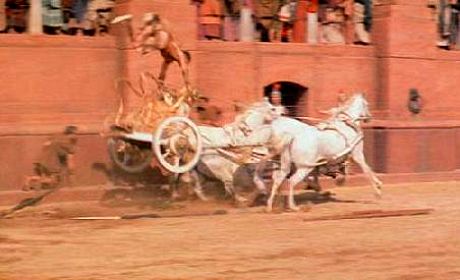
But I’ve always felt that the stuntman who flew upwards and hung on during that “accident” in William Wyler‘s chariot-race sequence (around the 4:50 mark) in the 1959 Ben-Hur deserved an award. This sequence has always meant a great deal because it was shot during an era when audiences could trust their eyes — i.e., it actually happened.
WSJ Spikes GasLand Quote
At the Four Seasons last night GasLand producer Trish Adlesic told me about a significant quote having been removed from a 2.26 Wall Street Journal story about her film. Matt Pitzarella, a spokesman for gas producer Range Resources Corp., told the WSJ’s Ben Casselman that “we have to stop blaming documentaries and take a look in the mirror.” The quote appeared online but was yanked sometime in the early evening.
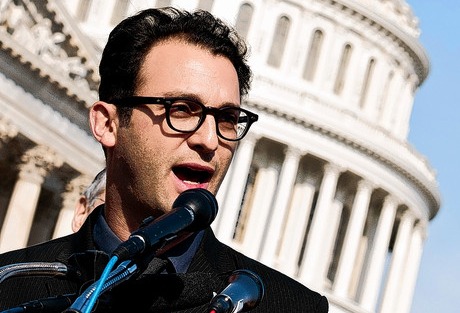
GasLand director Josh Fox
After speaking to GasLand director Josh Fox, HuffPost‘s Allison Rose Levy explained the gist in a story that went up around 3:11 am:
“Just as Josh Fox, director of the Oscar-nominated film, GasLand, was heading west to the Academy Awards, the Wall Street Journal reported on the gas industry’s losing campaign to discredit the film. An article, called ‘Oscar’s Attention Irks Gas Industry,’ by Ben Casselman, surveys the unsuccessful attempts to persuade the Academy of Arts and Sciences to pull the documentary.
“GasLand depicts nationwide instances of home water contamination near gas drilling sites that have been fracked. Fracking, or hydraulic fracturing, is a novel gas drilling process that introduced the use of large quantities of toxic chemicals.
“When the article was published on Friday night, it was the first time an industry spokesperson deployed a shift in strategy from the industry’s standard denials and repeated assertions that fracking is safe, despite the numerous reports of problems, such as flammable water, contamination of drinking water, trucks leaking toxic and radioactive waste-water on public highways, the pollution of streams, as well as fires, and explosions in which people have been injured.
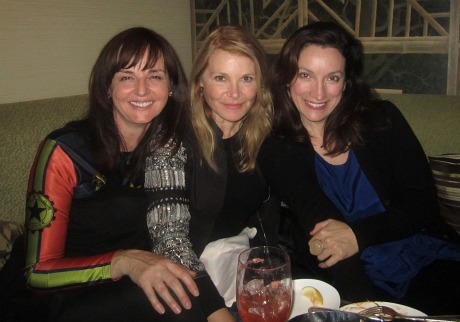
GasLand producer Trish Adlesic (right) with Inside Job co-dp Svetlana Cvetko (l.) and actress Helen Shaver (center) — Four Seasons hotel bar, Friday, 2.25, 9:25 pm.
“‘We have to stop blaming documentaries and take a look in the mirror,’ Matt Pitzarella, a spokesman for gas producer Range Resources Corp., was quoted as saying in WSJ.
“However, if you go to the article, you won’t find Pitzarella’s statement because within the hour the quote disappeared, say citizen journalists, who screen captured it and posted it on Twitter. GasLand director Fox, in Los Angeles, awaiting Sunday night’s Oscar ceremony, has questions:
“Why did this key quote disappear from the article? Why did the WSJ censor its own piece? Does the gas industry get to edit the Wall Street Journal?” Fox wondered. “Who pulled the quote?”
Here’s a screen capture of the originally-posted story:
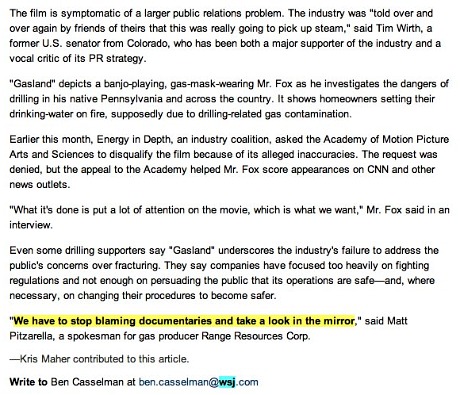
For The Record
This Roger Deakins quote is a few days old and has gotten around, but I’m posting it anyway because as “duhh” and after-the-fact as it may seem to some, it’s a significant benchmark statement from a guy of his stature: “This year or next will see more or less the end of film. It’s been a long time coming, really. Film has had a good run.”
Sphinx
In a 2.25 Oscar Picks column, The New Yorker‘s Richard Brody recalls Pauline Kael‘s famous comment after the 1972 Presidential election: “I live in a rather special world. I only know one person who voted for Nixon. Where they are I don’t know. They’re outside my ken. But sometimes when I’m in a theater I can feel them.” So it is, says Brody, with the people who’ve voted for The King’s Speech for Best Picture: “I don’t know anyone who feels that way about the movie, but plenty of them must be [out there].
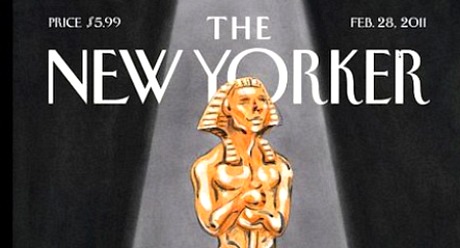
“The Social Network thoroughly deserves the Best Picture Oscar; based on the Academy’s record, that fact alone suffices to bet against it. It’s divisive in a way that The King’s Speech isn’t (but should be). British monarchs are to the big screen what kittens are to the computer screen.”
"Ghost"
Comparing yesterday morning’s jaunty, light-hearted who-is-Nikki Finke? piece on the Today show (scares people! blunt-spoken! extremely camera-averse!) to, say, Tad Friend‘s 10.12.09 New Yorker profile wouldn’t be fair, I suppose. But they couldn’t have blanded and dumbed it down much more than they did.
I’ve said before that I might understand Finke’s motive for not wanting to have current photos of her getting out. Some of us are more accepting of the process of inevitable biological diminishment than others, and some less so. But nobody is over-the-moon about it, and I’m guessing that Finke, like yours truly, has simply decided that visual capturings of same will never lighten anyone’s load, and that it’s probably better to leave well enough alone and get back to work with a cup of hot tea.
Drinking Again
“The fact of the matter is that this Oscar race is a wake-up call to what the awards really stand for…nothing. They get it wrong more than they get it right…FACT. In the past decade we have been spoiled by Oscar winners that didn’t fit the usual Oscar cliche. It led many to think we were seeing the rebirth of the Oscars and ‘could we finally respect their decisions’? If The Social Network, Inception or Black Swan wins then yes, the Oscars will have turned a new leaf. If The King’s Speech or The Fighter wins then no, the Oscars are the Oscars.” — Awards Daily‘s Sasha Stone quoting a 15 year-old kid from New Zealand, in an “editorial” called “Why Mark Zuckerberg Was Always Destined To Get No Further Than The Oscar Bike Room.”
Or, as I’ve put it a few times…forget it. I’ve said it too often. I feel like a condemned man sitting in a cell with some crackers, a hunk of brie cheese and a bottle of white wine, waiting to be hung.
That Happened
Congrats to L.A. Times reporter Geoff Boucher (pronounced “booshay”) for winning the press award at today’s 48th Annual ICG Publicists Awards. It was just nice to have been nominated. Thanks to all concerned for honoring and having me. It was cool to watch and hear Jacqueline Bisset read my name off as one of the nominees.
The parking situation at the Beverly Hilton hotel was absurd. The huge multi-level concrete lot out back is closed so the small adjacent garage was filled very quickly, and then there was a ridiculous line for valet. I finally gave up and parked three blocks away on little Santa Monica Blvd.
Legacy
Forbes guy Bill McCuddy says “it just dawned on me that The King’s Speech is Leno and The Social Network is Letterman. Everyone agrees Letterman is smarter, hipper, cooler. But Leno is the bread-and-butter, audience-friendly guy.”
McCuddy wrote this prior to going on CNN International to handicap Oscars and talk Harvey Weinstein‘s coup in getting The King’s Speech a new PG -13 rating, which director Tom Hooper “has always seemed cool to when I asked him about it several times over the last few weeks.” And yet the new rating, especially after Sunday night’s Oscar win, should net Speech another $30 or $40 million.
Side note. “What’s the over/under out there on how soon in the show show we get a Charlie Sheen joke? I say 5:42 seconds.”
The Story They Could Not Hang
USA Today‘s Susan Wloszczyna (a.k.a. “Suzie Woz”) today ran the umpteenth King’s Speech vs. Social Network Oscar culture war story. I wouldn’t have paid much attention (no offense) except that she said I was “among the most vehemently appalled” by the prospect of Speech beating Network, and also ran my quote about “comfort, contentment and middle-class Masterpiece Theatre milquetoast values [having] prevailed…kick me, shoot me, run me over with a double-decker bus.”

